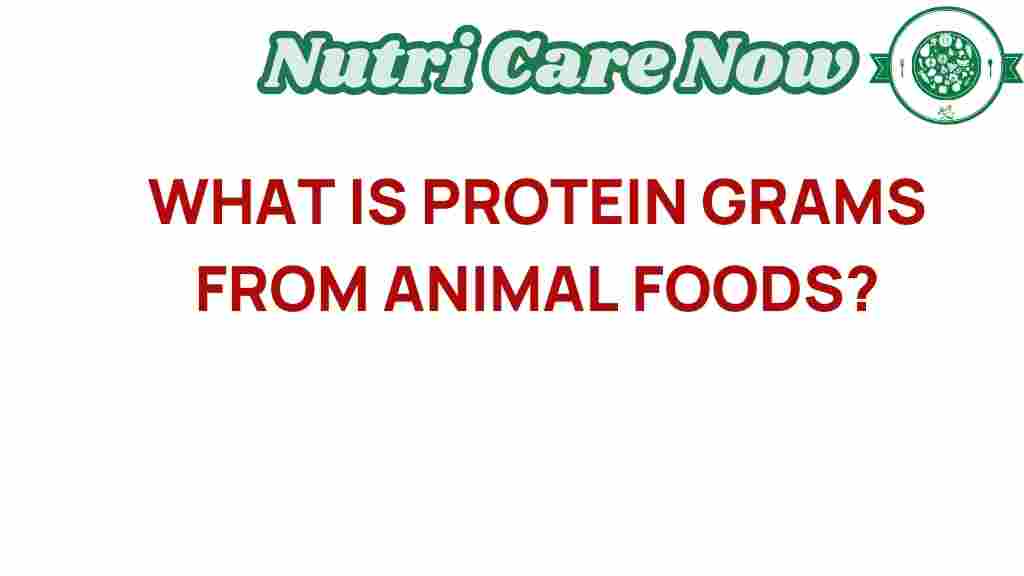Unlocking the Secrets of Protein Grams in Animal Foods
The world of nutrition is vast and often overwhelming, especially when it comes to understanding dietary protein and its sources. One of the most significant contributors to our daily protein intake is animal foods. In this article, we’ll explore the concept of protein grams, focusing on various animal foods such as meat, dairy, and eggs, and their health benefits for muscle growth and overall nutrition.
Understanding Protein and Its Importance
Protein is a vital macronutrient that plays a crucial role in various bodily functions. It is made up of amino acids, which are the building blocks for muscle, skin, enzymes, and hormones. The recommended daily intake of protein varies based on individual needs, but understanding how to measure protein grams in different foods is essential for optimizing your diet.
Why Focus on Animal Foods?
Animal foods are considered complete protein sources because they contain all nine essential amino acids that our bodies cannot produce on their own. This makes them particularly valuable for those looking to enhance muscle growth, maintain health, and support overall nutrition. Here’s a breakdown of some common animal food sources and their protein grams:
- Meat: Beef, pork, lamb, and poultry are excellent sources of protein with varying amounts of protein grams per serving.
- Dairy: Milk, cheese, and yogurt not only provide protein but also essential nutrients like calcium.
- Eggs: Often dubbed a superfood, eggs are a complete protein source and highly versatile in meals.
Protein Grams in Different Animal Foods
To facilitate better understanding, let’s dive deeper into the protein content of these animal foods:
1. Meat
Meat is a powerhouse of protein. Here’s a quick reference for protein grams in common meats:
- Chicken breast (cooked, skinless, 100g): approximately 31g of protein
- Beef (cooked, ground, 100g): approximately 26g of protein
- Pork (cooked, tenderloin, 100g): approximately 22g of protein
- Lamb (cooked, 100g): approximately 25g of protein
2. Dairy
Dairy products are not only rich in protein but also provide various other nutrients.
- Milk (whole, 1 cup): approximately 8g of protein
- Greek yogurt (plain, 1 cup): approximately 20g of protein
- Cheddar cheese (1 oz): approximately 7g of protein
- Cottage cheese (1 cup): approximately 28g of protein
3. Eggs
Eggs are often considered one of the most nutritious foods available.
- One large egg: approximately 6g of protein
- Two large eggs: approximately 12g of protein
Health Benefits of Animal Protein
Incorporating animal foods into your diet can offer numerous health benefits, particularly when it comes to protein:
- Muscle Growth: Protein is essential for muscle repair and growth, especially after exercise.
- Weight Management: High-protein diets can help with satiety, reducing overall calorie intake.
- Bone Health: Dairy products provide not only protein but also calcium, crucial for maintaining bone density.
- Improved Metabolism: Protein has a higher thermic effect compared to fats and carbohydrates, meaning your body burns more calories digesting it.
How to Incorporate More Protein Grams into Your Diet
Incorporating more protein grams from animal foods into your diet can be straightforward. Here’s a step-by-step process to ensure you get enough protein:
Step 1: Assess Your Protein Needs
Calculate your daily protein requirements based on your activity level, age, and health goals. A general guideline is:
- For sedentary adults: 0.8g of protein per kg of body weight
- For active individuals: 1.2-2.0g of protein per kg of body weight depending on the intensity of exercise
Step 2: Plan Your Meals
Use the protein content information provided earlier to plan meals that meet your protein needs. Consider including a variety of animal foods for a balanced intake.
Step 3: Track Your Intake
Utilize apps or a food diary to track your daily protein intake. This will help you stay on target with your protein grams goal.
Step 4: Experiment with Recipes
Incorporate protein-rich animal foods into your favorite recipes. Here are a few ideas:
- Grill chicken breast and serve it with a side of Greek yogurt dip.
- Add cottage cheese to smoothies for a protein boost.
- Make an omelet with vegetables and cheese for a nutritious breakfast.
Troubleshooting Common Protein Intake Issues
While increasing your protein intake, you might encounter some challenges. Here are some troubleshooting tips:
1. Lack of Variety
If you find yourself eating the same protein sources, try exploring different types of meat, dairy products, and egg recipes. This not only boosts your protein intake but also keeps meals exciting.
2. Dietary Restrictions
For those with dietary restrictions, consider alternative protein sources such as plant-based proteins combined with animal proteins, or focus on low-fat dairy options for weight management.
3. Meal Timing
Ensure you spread your protein intake throughout the day. Consuming protein with every meal can help maximize muscle protein synthesis.
Conclusion
Understanding protein grams in animal foods is essential for anyone looking to improve their nutrition and health. With a wealth of protein sources available, including meat, dairy, and eggs, it’s easier than ever to meet your dietary protein needs. By planning your meals and being mindful of your protein intake, you can enjoy the numerous health benefits associated with a protein-rich diet.
For more information on nutrition and dietary protein, visit Nutrition.org. To track your protein intake effectively, check out this helpful tool here.
This article is in the category Diet and created by NutriCareNow Team
